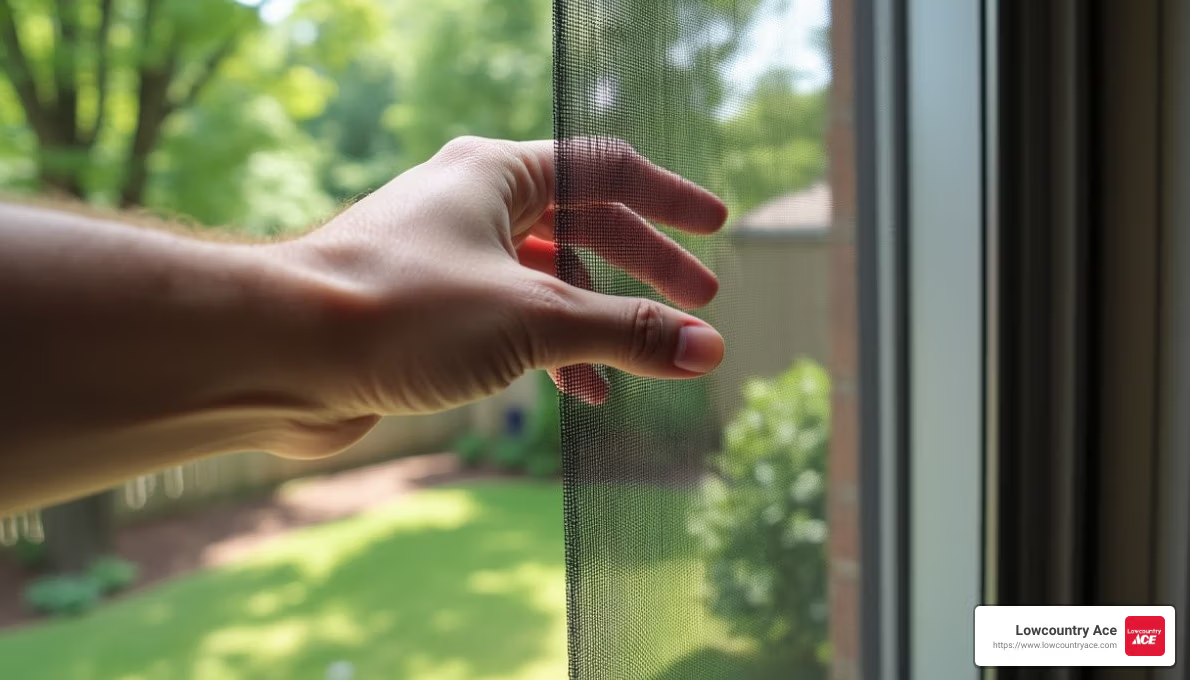Screen Door Repair: 5 Best Quick Solutions 2024
Screen door repair is essential for keeping your home’s ventilation perfect while ensuring pesky insects stay out. The most common issues homeowners face with their screen doors include torn screens, sticky sliding mechanisms, and broken hardware. To quickly address these problems, consider these initial steps:
- Inspect the Door: Check for visible tears or damage to the screen.
- Clean Tracks and Check Rollers: Remove debris and adjust misaligned rollers.
- Test Handles and Latches: Ensure they are functional and secure.
- Prepare Basic Tools: Keep a screwdriver, utility knife, and spline tool handy.
By addressing these straightforward tasks, you’ll maintain fresh air flow into your home without the hassle of insects.
The helpful team at Lowcountry Ace understands the challenges of screen door repair and provides local solutions to lift your home’s comfort and security. Our experienced staff is here to guide you with professional advice and trusted tools at every step.
Tools and Materials Needed
To tackle screen door repair like a pro, having the right tools and materials is crucial. Here’s a quick rundown of what you’ll need to get started:
Essential Tools
- Roller Tool:
-
This is a must-have for installing new spline. It helps press the spline into the groove, securing the mesh in place. Using a roller tool ensures a snug fit and prevents the screen from sagging over time.
-
Screwdriver:
-
Both flathead and Phillips head screwdrivers are useful. You’ll need these for removing handles, latches, and possibly the door from its frame.
-
Utility Knife:
-
A sharp utility knife is perfect for cutting excess screen mesh and trimming spline. Make sure it’s sharp for clean cuts, which help avoid fraying.
-
Scissors:
- Useful for cutting the screen material to size before securing it with spline. Scissors provide precision when cutting around corners or awkward shapes.
Materials
- Mesh Screening:
- Choose between fiberglass or aluminum mesh, depending on your needs. Fiberglass is flexible and easy to work with, while aluminum is more durable and resistant to damage. It’s important to measure your door frame accurately and add 2 inches on all sides before cutting.
- Spline:
- This is the rubber cord that holds the screen in place within the frame. Make sure to match the size of your old spline for a perfect fit. A spline that’s too thick or too thin can make installation difficult.
With these tools and materials on hand, you’ll be well-equipped to handle any screen door repair project. Proper preparation ensures a smoother process and a more professional finish.
The helpful team at Lowcountry Ace is ready to assist with any questions you might have about these tools or materials. Visit us for expert advice and supplies custom to your screen repair needs.
Step-by-Step Screen Door Repair
Repairing a screen door might seem daunting, but with the right steps, it becomes a straightforward task. Follow this guide to get your screen door back in top shape.
1. Remove the Door
Start by taking the door off its track. This gives you easy access to work on it. Use a screwdriver to detach any handles or latches, storing screws safely for reassembly. Place the door on a flat surface, like a table, for convenience.
2. Take Out Old Spline
The spline is the rubbery cord that holds the screen in place. Use a screwdriver to pry it out from the frame. Once you remove it, the old screen will come off easily. Discard the old spline, as you’ll need fresh material for the repair.
3. Remove Old Screening
With the spline gone, unroll the old screen. It might be dirty or torn, so dispose of it properly. This step preps the frame for new screening.
4. Roll Out New Screening
Lay the new mesh over the frame, ensuring it extends a couple of inches beyond each edge. This extra material makes it easier to handle during installation. Use scissors to cut the mesh to size.
DIY Tip: Fiberglass mesh is flexible and easy to work with, while aluminum mesh offers more durability.
5. Use the Roller Tool
A roller tool is essential for securing the mesh. Start by pressing the mesh into the frame’s grooves with the roller tool. Begin with the sides, then move to the top and bottom. This technique keeps the screen taut and smooth.
6. Roll In New Spline
Insert the new spline into the groove, starting at one corner. Use the roller tool to press it into place, ensuring the mesh stays tight. Work your way around the frame, creating two “L” shapes with the spline for a secure fit.
7. Cut Excess Spline and Screen
Once the spline is in place, trim off any excess with scissors. Use a utility knife to carefully cut away the extra mesh, pulling it away from the frame as you go for a clean edge.
8. Add the Door Handle and Hang the Door
Reattach the handle using the screws you set aside earlier. Finally, hang the door back on its track. Ensure it slides smoothly and that the screen is taut and secure.
Completing these steps not only repairs your screen door but also improves its durability. With the right tools and a bit of patience, you can achieve professional results right at home.
Common Screen Door Problems and Solutions
Screen doors are fantastic for letting in fresh air while keeping bugs out. However, they can run into problems over time. Let’s explore some common issues and how to fix them like a pro.
Damaged Screens
A torn or damaged screen is a common problem. Pets, weather, or accidents can cause tears. A damaged screen not only looks bad but also lets insects in.
Solution: Replace the screen. Use a flathead screwdriver to remove the spline, discard the old screen, and install a new one. Consider using fiberglass mesh for a flexible fit or aluminum mesh for durability. Follow our step-by-step guide to ensure a smooth process.
Misaligned Tracks
If your sliding screen door is hard to open or close, it might be misaligned. This can happen due to dirt in the tracks or worn rollers.
Solution: Start by cleaning the tracks. Use a vacuum to remove debris, then wipe with a damp cloth. For persistent issues, adjust the rollers. Locate the screws at the bottom of the door and turn them to raise or lower the door until it aligns correctly.
Broken Handles
Handles can break or become loose over time, making it difficult to open the door.
Solution: Replace the handle. Remove the screws holding the old handle in place, and attach a new one. Ensure the new handle is secure by tightening the screws properly.
Sticky Mechanisms
A sticky screen door can be frustrating. This often happens due to lack of lubrication or dirt buildup.
Solution: Clean the tracks and rollers thoroughly. Then, apply a lubricant specifically designed for sliding doors. This reduces friction and allows the door to glide smoothly.
By addressing these common problems, you can keep your screen door in excellent condition. Whether it’s a simple fix or a complete screen replacement, tackling these issues promptly ensures your door works efficiently and looks great.
Screen Door Repair Costs
When it comes to screen door repair, understanding the costs involved can help you make the best decision for your home and budget. Let’s break down the expenses for both DIY and professional repairs, as well as the material costs.
DIY Costs
Taking the DIY route can be cost-effective if you’re handy and have the right tools. Here’s a quick rundown of what you might spend:
- Screen Mesh: Depending on the type, fiberglass mesh can cost around $10 to $20 per roll, while aluminum mesh might be slightly more expensive.
- Spline and Roller Tool: A spline (the rubber cord that holds the screen in place) and a roller tool are essential for securing the mesh. These typically cost $5 to $15.
- Basic Tools: If you don’t already have them, you’ll need a flathead screwdriver, utility knife, and scissors. These are usually inexpensive, costing around $10 to $20 total.
In total, DIY repairs can cost anywhere from $25 to $55, depending on the materials you choose.
Professional Repair Costs
If you’re not comfortable with DIY repairs or simply don’t have the time, hiring a professional might be the way to go. Here’s what you can expect:
- Labor Costs: Professional repair services usually charge between $50 and $100 per hour. The total cost will depend on the complexity of the repair and the rates in your area.
- Materials: Some professionals include materials in their service fee, while others charge extra. Be sure to ask for a detailed estimate.
Overall, professional repairs can range from $75 to $150, depending on the service provider and the extent of the repairs needed.
Material Costs
The cost of materials can vary based on your choices:
- Fiberglass Mesh: This is generally the most affordable option, costing between $0.20 and $0.50 per square foot.
- Aluminum Mesh: This option is more durable and can cost between $0.30 and $0.70 per square foot.
- Pet-Resistant or Solar Screens: These specialty screens are designed for specific needs and can be pricier, ranging from $0.50 to $1.00 per square foot.
When planning your screen door repair, consider both the initial costs and the long-term benefits of your chosen materials. Investing in quality materials can save you money in the long run by reducing the need for frequent repairs.
Next, we’ll answer some frequently asked questions about screen door repair to help you make informed decisions.
Frequently Asked Questions about Screen Door Repair
How much does it cost to replace a mesh on a screen door?
Replacing the mesh on a screen door can be a budget-friendly project, especially if you opt for a DIY approach. Fiberglass mesh is your most affordable option, priced around $0.20 to $0.50 per square foot. If you prefer aluminum mesh for its durability, expect to pay between $0.30 and $0.70 per square foot. For those with pets or specific needs, pet-resistant and solar screens are available, but they cost a bit more, ranging from $0.50 to $1.00 per square foot.
Is it hard to rescreen a screen door?
Rescreening a screen door isn’t as hard as it seems, especially if you have the right tools and follow a few simple steps. You’ll need:
- Roller Tool: Essential for pressing the spline into the frame.
- Mesh Screening: Choose between fiberglass or aluminum, based on your needs.
- Spline: The rubber cord that holds the screen in place.
- Screwdriver and Utility Knife: For removing the old screen and trimming the new one.
With these tools in hand, rescreening becomes a straightforward task. Start by removing the door, taking out the old spline, and lifting off the damaged screen. Next, lay the new screen over the frame, roll in the new spline, and trim any excess. Finally, reattach the door.
Can you repair a hole in a screen door?
Yes, you can repair a hole in a screen door without replacing the entire mesh. Repair kits and patches are available for quick fixes. These kits usually include adhesive patches that you can cut to size and apply directly over the hole.
For small holes, a patch can be a quick and effective solution. Simply clean the area around the hole, cut the patch to size, and press it firmly onto the screen. Larger damages might require replacing the mesh entirely, but for minor wear, a patch will do the trick.
By understanding the costs, tools, and methods involved in screen door repair, you can confidently tackle any issues that arise. Whether you’re replacing a mesh, rescreening, or patching a hole, these solutions will keep your screen door in top shape.
Conclusion
When it comes to screen door repair, having the right support and expertise makes all the difference. At Lowcountry Ace, we’re not just a hardware store; we’re your partners in maintaining a comfortable and functional home. Our commitment to the Charleston community means we’re always here to offer expert advice and top-notch customer service.
Whether you’re tackling a DIY screen repair or seeking professional assistance, our knowledgeable team is ready to guide you every step of the way. We provide high-quality materials and tools, ensuring your repair projects are successful and long-lasting. From selecting the right mesh to offering step-by-step guidance, we have everything you need to fix it like a pro.
Visit us at Lowcountry Ace on James Island, and experience the convenience and expertise that our local store offers. Let us help you keep your screen doors in excellent condition, enhancing your home’s comfort and aesthetics. For more information, check out our screen repair services and see how we can assist you today.
Lowcountry Ace Hardware: Your one-stop shop for home improvement. We offer quality products from trusted brands and expert advice from our experienced staff. Located on James Island, visit us for tools, hardware, fishing gear, power tools, building materials, grills & smokers, electrical and plumbing supplies, and more.






